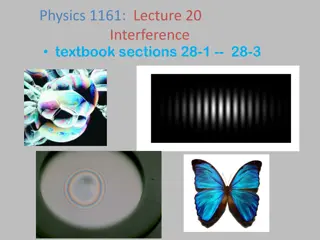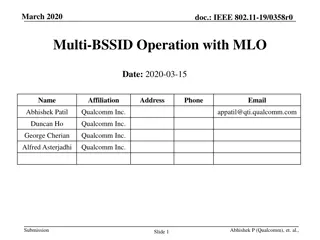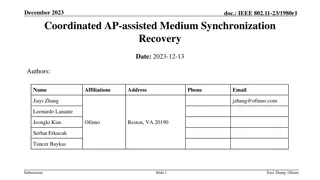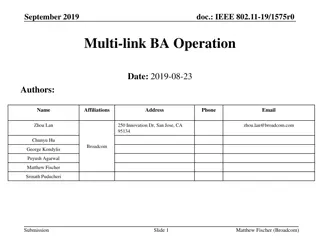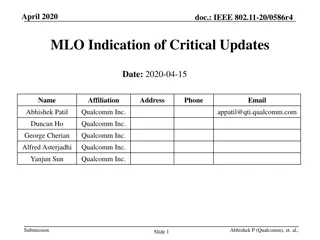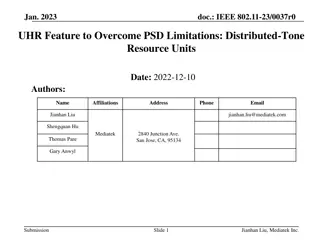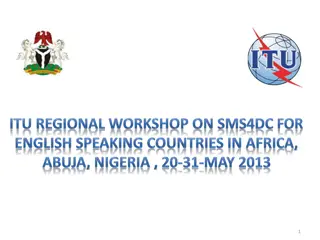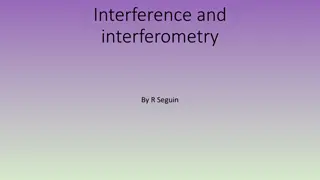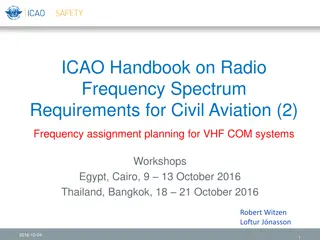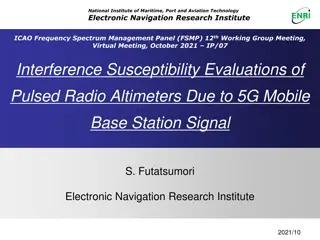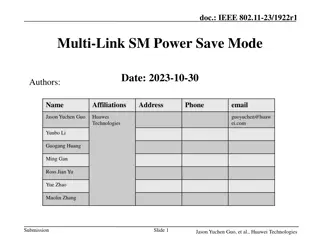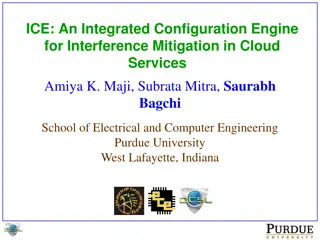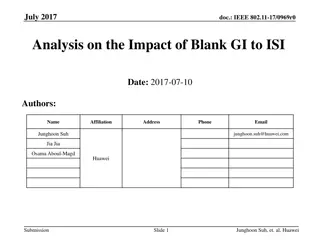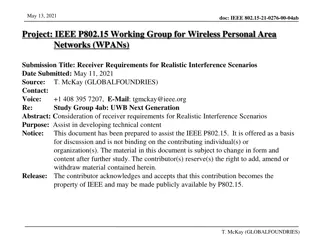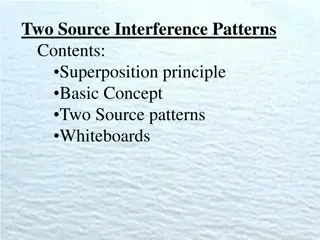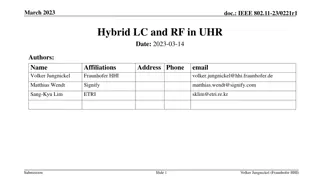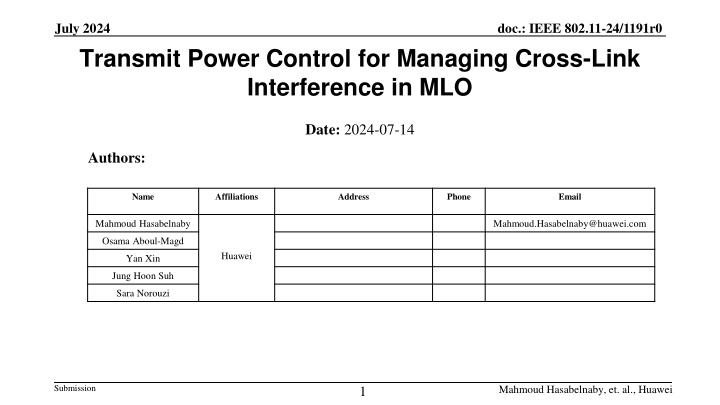
Transmit Power Control for Managing Cross-Link Interference in MLO
"This paper introduces a transmit power control method for managing cross-link interference in Multi-Link Operations (MLO). It addresses the challenges of simultaneous transmit and receive (STR) operations in multi-link environments, providing insights and solutions for efficient and reliable wireless communications."
Download Presentation

Please find below an Image/Link to download the presentation.
The content on the website is provided AS IS for your information and personal use only. It may not be sold, licensed, or shared on other websites without obtaining consent from the author. If you encounter any issues during the download, it is possible that the publisher has removed the file from their server.
You are allowed to download the files provided on this website for personal or commercial use, subject to the condition that they are used lawfully. All files are the property of their respective owners.
The content on the website is provided AS IS for your information and personal use only. It may not be sold, licensed, or shared on other websites without obtaining consent from the author.
E N D
Presentation Transcript
doc.: IEEE 802.11-24/1191r0 July 2024 Transmit Power Control for Managing Cross-Link Interference in MLO Date: 2024-07-14 Authors: Name Affiliations Address Phone Email Mahmoud Hasabelnaby Mahmoud.Hasabelnaby@huawei.com Osama Aboul-Magd Huawei Yan Xin Jung Hoon Suh Sara Norouzi Submission Mahmoud Hasabelnaby, et. al., Huawei 1
doc.: IEEE 802.11-24/1191r0 July 2024 Abstract In this contribution, we propose a transmit power control method for simultaneous transmit and receive (STR) multi-link operations to manage cross- link interference. 2 Submission Mahmoud Hasabelnaby, et. al., Huawei
doc.: IEEE 802.11-24/1191r0 July 2024 Background (1/3) Simultaneous Transmit and Receive (STR) transmission mode allows AP/non-AP multi-link devices (MLDs) to transmit frames asynchronously on multiple links [1]. Offers high potential for higher throughput and lower delay. However, STR mode can cause a cross-link interference over operating links between AP/non-AP MLDs unless their channels are sufficiently away. It mainly would occur between insufficient separated channels in a band (e.g., 2 channels in 5 GHz with very small channel gap). Obviously, when cross-link interference occurs, it impacts ongoing transmissions/receptions over the affected links, leading to potential packet loss, increased delay, and reduced reliability [2], [3]. Better addressing the cross-link interference issue is important for efficient and reliable UHR multi-link operations [4]. 3 Submission Mahmoud Hasabelnaby, et. al., Huawei
doc.: IEEE 802.11-24/1191r0 July 2024 Background (2/3) Evading cross-link interference by selecting distant operating channels across multi- links might not always be feasible. In this case, simultaneous TX/RX operations might be restricted for certain link channel combinations for affiliated AP/non-Aps, known as Non-Simultaneous Transmit and Receive (NSTR) [1]. During NSTR, restricted channel access rules or EDCA backoff suspension mechanisms can be deployed to mitigate cross-link interference in MLO [5], [6]. Before initiating TXOP on one link, the AP MLD must verify the status of the other interfering link. The AP MLD should not initiate TX operation or suspend EDCA backoff countdown on one link if the other interfering link is in RX state. If the other interfering link is in TX state, the affiliated AP/non-AP STA should limit its own TX duration to match the end of the other transmissions. 4 Submission Mahmoud Hasabelnaby, et. al., Huawei
doc.: IEEE 802.11-24/1191r0 July 2024 Background (3/3) Through using NSTR mode, cross-link interference issue is solved, but at the cost of increased delay and reduced throughput at the NSTR AP/non-AP MLDs with transmit/receive constraints. AP/non-AP MLDs cannot simultaneously transmit in one link and receive in another adjacent interfering link due to potential power leakage. Under certain conditions, multi-link operation will be converging to a single link operation. Increased complexity, especially in end-time alignment methods due to the required synchronization of TX/TX and RX/Rx operations. In delay-sensitive applications (e.g., Industrial IoT, online gaming applications), the delay requirements are indeed stringent, and switching to NSTR mode might not be feasible. 5 Submission Mahmoud Hasabelnaby, et. al., Huawei
doc.: IEEE 802.11-24/1191r0 July 2024 Proposal: TX Power Control in MLO One way to manage the cross-link interference in STR multi-link operations, while retaining many benefits of the STR mode, is to adapt the transmission power values on the impacted links. 1. A STA MLD informs an AP MLD of the minimum and maximum transmit power capability for the current channel over each affiliated STA AP MLD STA MLD 2. Process input data 3. AP MLD informs each affiliated STA with STA MLD with its local transmit power constraint AP MLD checks if the frequency gap between affiliated STA ? and affiliated STA ? > certain non-zero threshold value Yes No No cross-link interference. AP MLD sets the local transmit power for affiliated STA ? and affiliated STA ? to their respective maximum transmit power capability values Cross-link interference exists. AP MLD sets the local transmit power for affiliated STA ? and affiliated STA ? to their respective minimum transmit power capability values 6 Submission Mahmoud Hasabelnaby, et. al., Huawei
doc.: IEEE 802.11-24/1191r0 July 2024 Proposal: TX Power Control in MLO STA MLD set the minimum and maximum transmit power capabilities for each affiliated STA to ensure reliable communication based on the regulatory requirement, distance, channel conditions, and device hardware capability. AP MLD select the local transmit power constraint for each affiliated STA as the maximum power value that affiliated STA can use to transmit in order to manage cross-link interference. In the absence of cross-link interference, the AP MLD can set the local transmit power for affiliated STAs to any value less than their respective maximum power capability values based on the presence of other interference sources in the network or for power consumption saving. The transmit power capability information and local transmit power constraint can be exchanged during the ML Setup in (re)association request and response frames, respectively. 7 Submission Mahmoud Hasabelnaby, et. al., Huawei
doc.: IEEE 802.11-24/1191r0 July 2024 Proposal: TX Power Control in MLO The local transmit power constraint per affiliated STA can be applied all the time or within a specific period and signaling has to be defined accordingly. Updating the local transmit power constraint might be necessary when an interfering link is added (activated) or removed (disabled). The transmit power capability of affiliated STA(s) might need adjustments based on dynamic channel conditions and the mobility of the STA MLD. The STA MLD can update its power capability information and request updating local power constraint for affiliated STA(s) using a Link Reconfiguration Request frame, to which the AP MLD will respond with a Link Reconfiguration Response frame. An AP MLD may recommend to update the local power constraint for a certain affiliated STA associated to a non-AP MLD by sending a Link Reconfiguration Notify frame. 8 Submission Mahmoud Hasabelnaby, et. al., Huawei
doc.: IEEE 802.11-24/1191r0 July 2024 Proposal: TX Power Control Signaling New multi-link transmit power capability and constraint elements can be proposed for managing the transmit power control in MLO. Also, both the Basic and Reconfiguration Multi-Link elements can be extended to include the power capabilities information/the local transmit power constraint for each affiliated STAs. Non-AP/AP MLD will include Basic Multi-Link Element in a (Re)Association Request/Response frame, to report the power capabilities information/the local transmit power constraint for each affiliated STAs during ML Setup. Non-AP/AP MLD will include Reconfiguration Multi-Link Element in a Link Configuration Request/Response frame, to update the power capabilities information/the local power constraint for affiliated STA(s) based on the dynamic change in the network. 9 Submission Mahmoud Hasabelnaby, et. al., Huawei
doc.: IEEE 802.11-24/1191r0 July 2024 Proposal: Extended Basic Multi-Link Element The format of the STA Control field of the extended Basic Multi-Link element: The format of the STA Info field of the extended Basic Multi-Link element: STA MLD set the Power Capabilities Present subfield to 1 to indicate the Minimum and Maximum Power Capabilities subfields are present in the STA Info field. AP MLD set the Transmit Power Constraint Present subfield to 1 to indicate the Transmit Power Constraint subfield is present in the STA Info field. 10 Submission Mahmoud Hasabelnaby, et. al., Huawei
doc.: IEEE 802.11-24/1191r0 July 2024 Proposal: Extended Reconfiguration Multi-Link Element The format of the STA Control field of the extended Reconfiguration Multi-Link element: TX Power Update 6 The format of the STA Info field of the extended Reconfiguration Multi-Link element: 11 Submission Mahmoud Hasabelnaby, et. al., Huawei
doc.: IEEE 802.11-24/1191r0 July 2024 Summary Cross-link interference has been a significant issue in STR multi-link operations. In this contribution, we introduced a power control method that is aware of cross-link interference, enabling simultaneous uplink and downlink transmissions over impacted links by adjusting the transmission power values on the affected links. The proposed solution offers flexible power control based on the frequency gap between affiliated stations (STAs), the presence of cross-link interference, and the dynamic changes of the network. This solution is particularly beneficial for delay-sensitive applications such as IoT devices operations, where the delay requirements are stringent. In this contribution, we also introduced extended elements/signaling approaches for the exchange/update of power capabilities and constraints information between AP/non-AP MLDs, improving the management of multi-link operations. 12 Submission Mahmoud Hasabelnaby, et. al., Huawei
doc.: IEEE 802.11-24/1191r0 July 2024 References [1] IEEE P802.11be/ D5.0, January 20, 2024. [2] Liwen Chu, et.al., IEEE 802.11-23/1934r0, In-device interference mitigation follow up . [3] Alfred Asterjadhi, et.al., IEEE 802.11-23/1964r0, Coexistence Protocols for UHR . [4] Rubayet Shafin, et.al., IEEE 802.11-24/0509r0, Thoughts on Co-Ex and P2P for 11bn . [5] Dmitry Akhmetov, et.al., IEEE 802.11-19/1541r1, Performance aspects of Multi-link operations with constraints . [6] Matthew Fischer, et.al., IEEE 802.11-20/0081r3, MLO Synchronous Transmission . 13 Submission Mahmoud Hasabelnaby, et. al., Huawei



